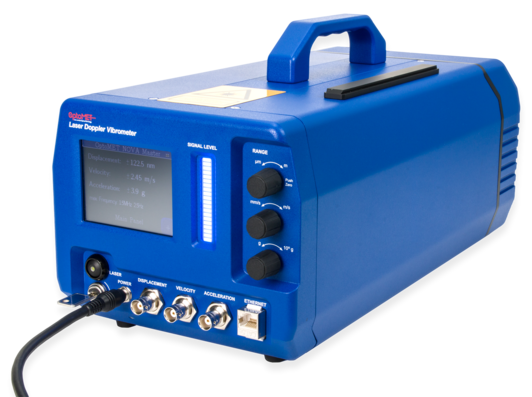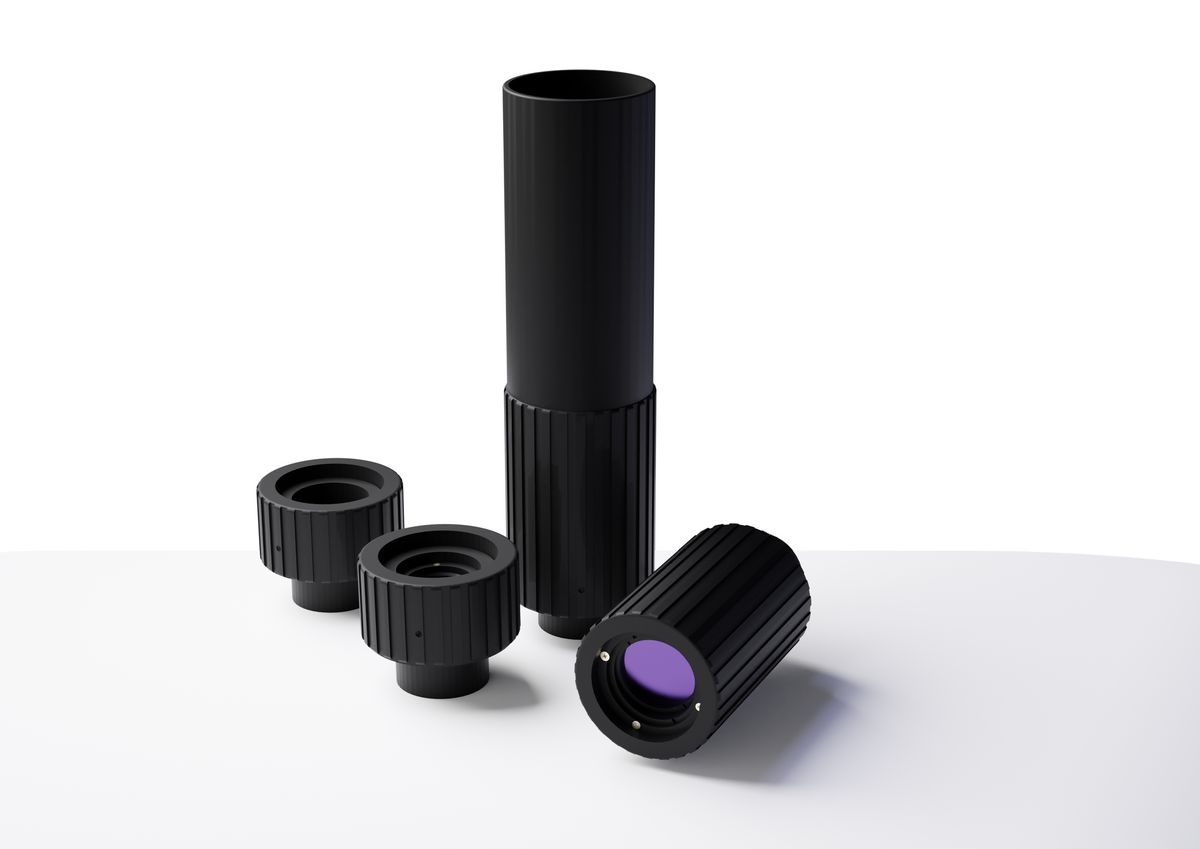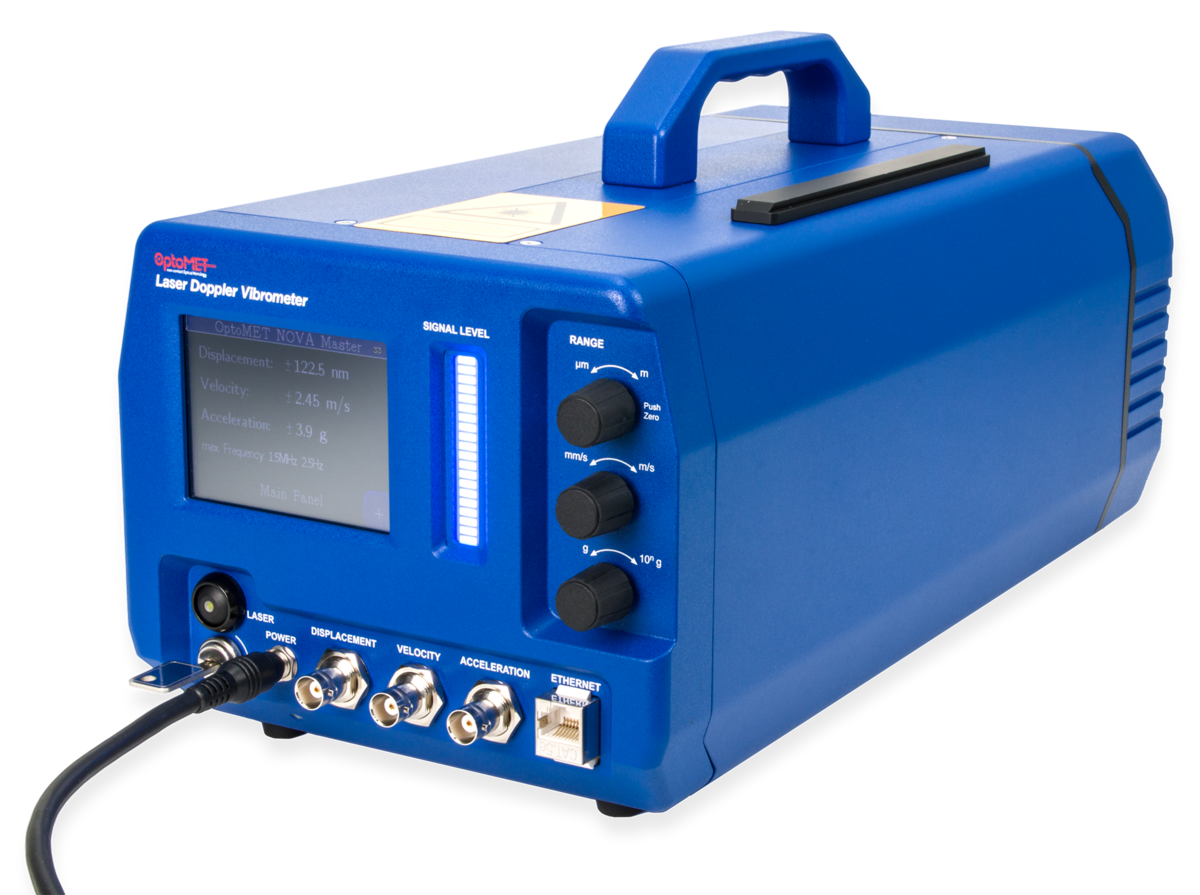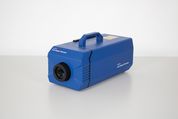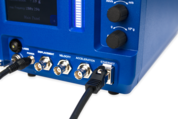Nova Series: Digital Free Beam SWIR Laser Vibrometer
Detect nearly all types of vibrations with our robust, surface-property-insensitive system.
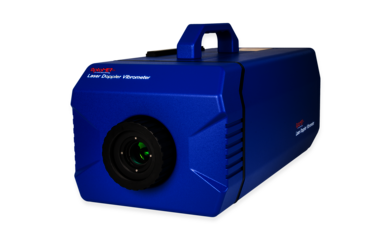
Download the suitable datasheet and our new brochure:
Download the suitable datasheet and our new brochure:
Measure on dark and rough surfaces and on rotating objects

The Nova series is a modern and digital free beam laser Doppler vibrometer (LDV), which works with a SWIR measuring laser (Short-Wavelength-InfraRed; SWIR). The Nova series is essential when every decibel is important for the signal level or exceptional dynamic range is required. Typical scenarios relate to structures that reflect visible light poorly, such as dark and rough surfaces or biological tissue. Even when measuring over long distances, for example in construction or on glowing surfaces such as turbine blades in the aerospace industry or in vehicle and plant construction, the signal strength is crucial.
Measurements on carbon composite panels or other non-cooperative materials can be carried out just as easily as measurements at distances of more than 200 m, without the need to treat the surface of the measurement object.
Infrared Laser Vibrometry – Measure on all Surfaces!
The short-wave infrared (SWIR) laser source installed in the Nova series enables measurements without surface treatment even on the most difficult surfaces with a high signal-to-noise ratio (SNR), be it deep black, incandescent metal or glass.
Higher Laser Power
The wavelength of 1,550 nm used allows an output power up to 10 mW, being ten times higher compared to HeNe systems. Nevertheless, maximum eye safety with laser protection class 1 is given.
Efficient Photodetectors
Photodetectors in this wavelength range have an efficiency of more than 98%. In conjunction with the higher laser power, the signal level is 20 dB higher than that of conventional laser Doppler vibrometers.
Stability
With just a single longitudinal laser mode, the sensitivity is independent of changes in the measuring distance. The immediate operational readiness of the device after switching on and stability against fluctuations in the ambient temperature are further advantageous properties.
Benefits of the Optomet Vibrometers
Further properties common to all Optomet vibrometry systems such as universal digital signal processing, real portability or intuitive hardware and software are described in more detail in the product-overview.
High Dynamic Range
Characteristics - Nova Series Laser Vibrometer
- Non-contact vibration measurement up to 25 MHz
- End-to-end digital workflow
- 15 velocity-, 19 displacement- und 15 acceleration measuring ranges
- Vibrational velocities up to ±30 m/s
- Displacement resolutions down to 50 Femtometer
- Decoder remote update- and upgradeable
- Higher signal level due to SWIR laser, independent of working distance
- Coaxial, green targeting laser
- Digital- and analog output
- Compact and portable All-in-One design
- Intuitive Handling
- High power efficiency
Technical Specifications
A detailed list of all vibrometer characteristics, including all hardware and software features, can be found in the vibrometer data sheet in Support & Datasheets.
| Category | Characteristics |
|---|---|
| Laser source | SWIR-Laser |
| Laser wavelength | Measurement laser: 1550 nm |
| Targeting laser: 510-530 nm | |
| Laser class | Measurement laser: output power: <10 mW, class 1 |
| Targeting laser: output power: <1 mW, class 2 | |
| Measured quantity | Velocity, Displacement, Acceleration |
| Frequency bandwidths | DC to 25 MHz |
| Max. vibrational velocity | 25 m/s |
| Output signal (digital) | GBit-Ethernet (RJ45) / WiFi |
| Output signal (analogue) | 3 x Standard BNC connectors |
| Signal processing | Digital (Optomet UltraDSP) |
| User interface output | Color screen 3.5" + 20 segment LED bargraph |
| User interface input | Touch screen, knobs with push-button, key switch (power) |
| Dimensions | Length x width x height (excluding handle and lens): 380 x 180 x 148 mm |
| Weight | 8 kg |
| Mounting | Standard tripod screw thread |
| Power supply | 110 -240V AC (50-60Hz) oder 12V DC |
| Power consumption | 27 Watt |
| Operating temperature range | 0°C to 40°C |
Laser Vibrometer Measuring- & Data Acquisition Software
OptoGUI Software
OptoGUI is an extensive and intuitive software for remote control, data acquisition, and data analysis when working in single-point mode. Data transfer is realized via a loss-free digital Gigabit Ethernet connection. Click for detailed information about OptoGUI.
Available Decoders
A wide variety of high-performance real-time decoders are available for the evaluation of the interferometric measuring signals. The Optomet UltraDSP technology enables the measurement of frequencies up to 25 MHz and vibrational velocities up to 25 m/s with the Nova-Series, displacements can be resolved to less than 100 fm. All vibrometers incorporate a velocity decoder, and displacement and acceleration decoders are optionally available. Numerous measuring ranges per decoder ensure that measurements can always be performed with the optimum sensitivity.
Decoders can be easily retrofitted or upgraded. Start with a basic system and adapt the capabilities of the measuring instrument as required. This requires no return of the instrument to the factory and no waiting times for your production or research project. The table below provides an overview of the configuration options. We will also be happy to assist you in the selection of the best decoder for your measuring task.
Start
Decoder Name | Number of measuring ranges | Max. vibrational velocity | Frequency | Comments |
|---|---|---|---|---|
7 | 2.5 m/s | DC - 100 kHz | required | |
19 |
|
| optional | |
7 |
|
| optional |
Basis
Decoder Name | Number of measuring ranges | Max. vibrational velocity | Frequency | Comments |
|---|---|---|---|---|
8 | 5 m/s | DC - 500 kHz | required | |
19 |
|
| optional | |
8 |
|
| optional |
Sense
Decoder Name | Number of measuring ranges | Max. vibrational velocity | Frequency | Comments |
|---|---|---|---|---|
11 | 5 m/s | DC - 1 MHz | required | |
19 |
|
| optional | |
11 |
|
| optional |
Sense Remote
Decoder Name | Number of measuring ranges | Max. vibrational velocity | Frequency | Comments |
|---|---|---|---|---|
11 | 5 m/s | DC - 25 kHz | required | |
19 |
|
| optional | |
11 |
|
| optional |
Sense Speed
Decoder Name | Number of measuring ranges | Max. vibrational velocity | Frequency | Comments |
|---|---|---|---|---|
12 | 12 m/s | DC - 1 MHz | required | |
19 | optional | |||
12 | optional |
Speed
Decoder Name | Number of measuring ranges | Max. vibrational velocity | Frequency | Comments |
|---|---|---|---|---|
9 | 12 m/s | DC - 2,5 MHz | required | |
12 |
| optional | ||
9 |
| optional |
High Speed
Decoder Name | Number of measuring ranges | Max. vibrational velocity | Frequency | Comments |
|---|---|---|---|---|
11 | 25 m/s | DC - 2,5 MHz | required | |
19 |
|
| optional | |
11 |
|
| optional |
Ultra High Speed
Decoder Name | Number of measuring ranges | Max. vibrational velocity | Frequency | Comments |
|---|---|---|---|---|
12 | 30 m/s | DC - 2,5 MHz | required | |
19 |
|
| optional | |
12 |
|
| optional |
High Frequency
Decoder Name | Number of measuring ranges | Max. vibrational velocity | Frequency | Comments |
|---|---|---|---|---|
9 | 12 m/s | DC - 10 MHz | required | |
19 |
|
| optional | |
11 |
|
| optional |
Master
Decoder Name | Number of measuring ranges | Max. vibrational velocity | Frequency | Comments |
|---|---|---|---|---|
14 | 25 m/s | DC- 10 MHz | required | |
19 |
|
| optional | |
14 |
|
| optional |
Master+
Decoder Name | Number of measuring ranges | Max. vibrational velocity | Frequency | Comments |
|---|---|---|---|---|
14 | 25 m/s | DC- 25 MHz | required | |
19 |
|
| optional | |
14 |
|
| optional |
Master++
Decoder Name | Number of measuring ranges | Max. vibrational velocity | Frequency | Comments |
|---|---|---|---|---|
15 | 30 m/s | DC- 25 MHz | required | |
19 |
|
| optional | |
15 |
|
| optional |
Available Lenses
Several lenses are available which are optimized for the Nova-Series. Choose the right optical system based on working distance, reflectivity of the surface to be measured or size of the focus point. The lenses are easily exchangeable due to a bayonet lock as on single-lens reflex cameras.
The table below provides an overview of the configuration options. We will also be happy to assist you in the selection of the best lens for your measuring task.

Short-Range Interchangeable lens
- Working distance: 6 mm ... 5 m
- Autofocus, remote focus, manual focus
- Focus spot size (typ.): 25 µm at 6 mm

Mid-Range Interchangeable lens
- Working distance: 125 mm ... 10 m
- Autofocus, remote focus, manual focus
- Focus spot size (typ.): 43 µm at 125 mm

Long-Range Interchangeable lens
- Working distance: 450 mm ... 100 m
- Autofocus, remote focus, manual focus
- Focus spot size (typ.): 67 µm at 450 mm

Super-Long-Range Interchangeable lens
- Working distance: 2300 mm ... 200 m
- Autofocus, remote focus, manual focus
- Focus spot size (typ.): 245 µm at 2300 mm
Device Datasheet & Information about Laser Vibrometry
Accessories

Single Point Vibrometer Transport Case
Stable and waterproof Peli case for safe keeping and transport of vibrometer.
External dimension (L x B x H): 61.9 x 49.2 x 22.3 cm
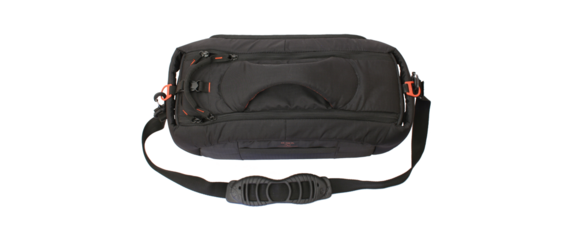
Transport Bag
Compact und light transport bag for the outdoors-measurements

Telescope
For measurements from a greater distance, a telescope makes it easier to find the measuring point. The telescope can be easily mounted on the gauge rail at the top of the vibrometer.

IR-Camera
For digital visualizing of the laser point. The camera can be easily mounted on the gauge rail at the top of the vibrometer.

IR-Detector Card
Transforming the not-visible infrared light into a spot of visible light.

Mobile Battery
Portable battery charger, external battery power bank. For powering the vibrometer when performing outdoor measurements.

Tripod with Fluid Head
Precisely align your vibrometer with high quality tripods by Manfrotto




